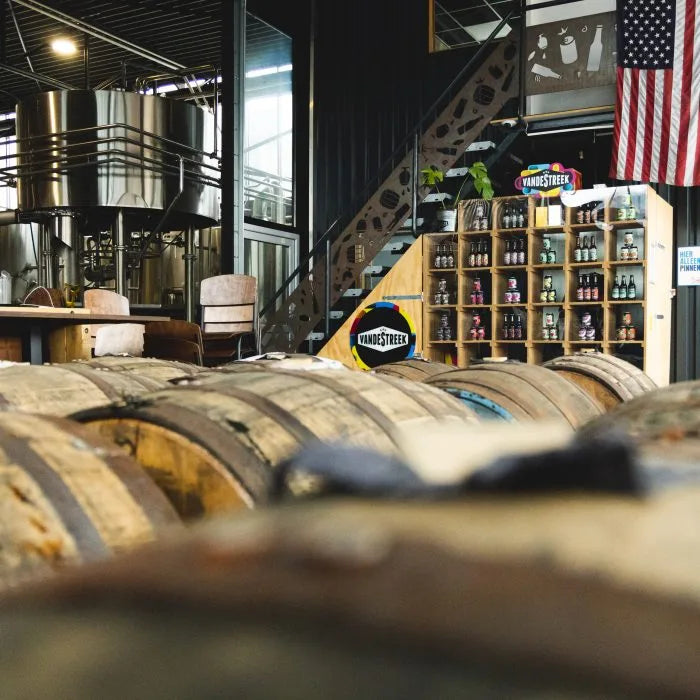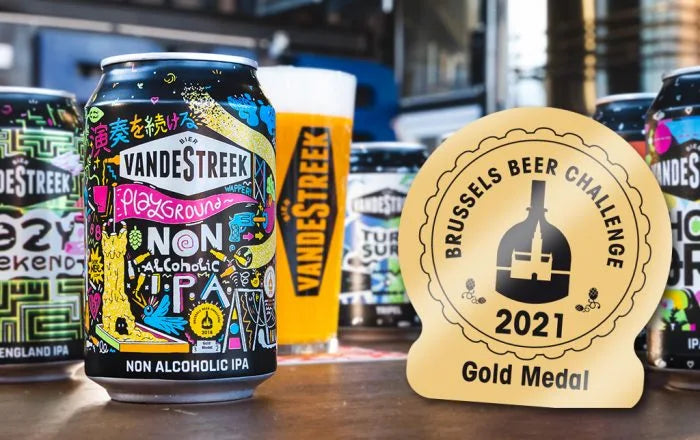- News
- /
vandeStreek in barrels

When you enter the vandeStreek tasting room in Utrecht, you will see a small rack with barrels on the left of the bar. There are more barrels in the back of the brewery. In 2017 there were about 100 pieces, but that was a bit much. However, there are still more than enough to store beautiful beers in barrels. Or, as it is called in beautiful English, for the barrel aging. Every fall, the beers are removed from the barrel and canned for enthusiasts. But which beer goes on which barrel? Which flavors go together? How much beer actually goes into such a keg? The barrel masters of the brewery explain it.
Ronald opens a can of Weizen Doppelbock, aged on Islay casks. The smoky peat of the Islay whiskey is here coupled with the sweet maltiness of the doppelbock. “So this is different from what we normally do,” says Sander. “We put most of the beers in barrels where we know that the flavors support each other. With this beer it is contrasting, and that works well. This beer actually immediately explains why we barrel age beers: to learn from it and to discover flavors. It is our hobby within the hobby.”
Support
Most beers that go into barrels therefore get a supporting taste. And most of beers are stouts. “We brew a double mash Imperial Stouts every year for the cold winter days, such as the Risky Business,” says Ronald. “That beer is very suitable for barrel aging. A stout carries a different taste very well; so it goes well on, for example, rum, whiskey or cognac barrels. What we really like is a stout combined with the sweetness of Bourbon casks.”
“So we choose the beer and barrel combinations according to taste,” Sander continues, “but we do alternate each year. The Barrel Hazard, for example, is a stout that has been aged in bourbon barrels. The Barrel Wave has been in bourbon and whiskey barrels. That combination gives different tones. And we can even play within the bourbon or whiskey style,” Sander laughs. “A barrel that has contained Weller wheat bourbon gives a different taste than a barrel of Jack Daniels or Heaven Hill.”
To learn
“We really want to learn from this,” explains Ronald. “Realize that we have everything under control in the brewery. Each beer is tested and tasted and we now know what flavor will come out of the kettle when we write the recipe. Barrel aging has a degree of uncertainty in it. You don't know what the keg has done to the beer until you taste it after a few months. That makes it exciting and educational. We have now come to the point where we also know what we are doing here. Name a barrel, and I'll name a beer style that goes with it.”
Stouts therefore go well on whiskey and bourbon barrels, including those Islay barrels that give a peat and smoke flavor. “But also on Speyside casks,” says Sander, “that makes the stout very smooth. And a rum barrel is very nice for a spicy red ale, for example. What has also become very beautiful is the Ceaux Cane on Cognac barrels.” To prove it, he pours the beer. The warming and fresh sour apple flavor of the cognac indeed combines very nicely with the light smokiness and light pepperiness.
vandeStreek therefore has different types of barrels in the brewery. “We want to go to 50 barrels,” says Ronald, “that's enough for 3 to 4 barrel aged beers for the season. One barrel holds 2 hectoliters, so 50 barrels are good for 100 hectoliters of beer. That's enough for the season." It's about 30,000 cans of beer for the lover of heavy beers with barrel-aged flavors. Enough to drink a second can of your favorite beer.

